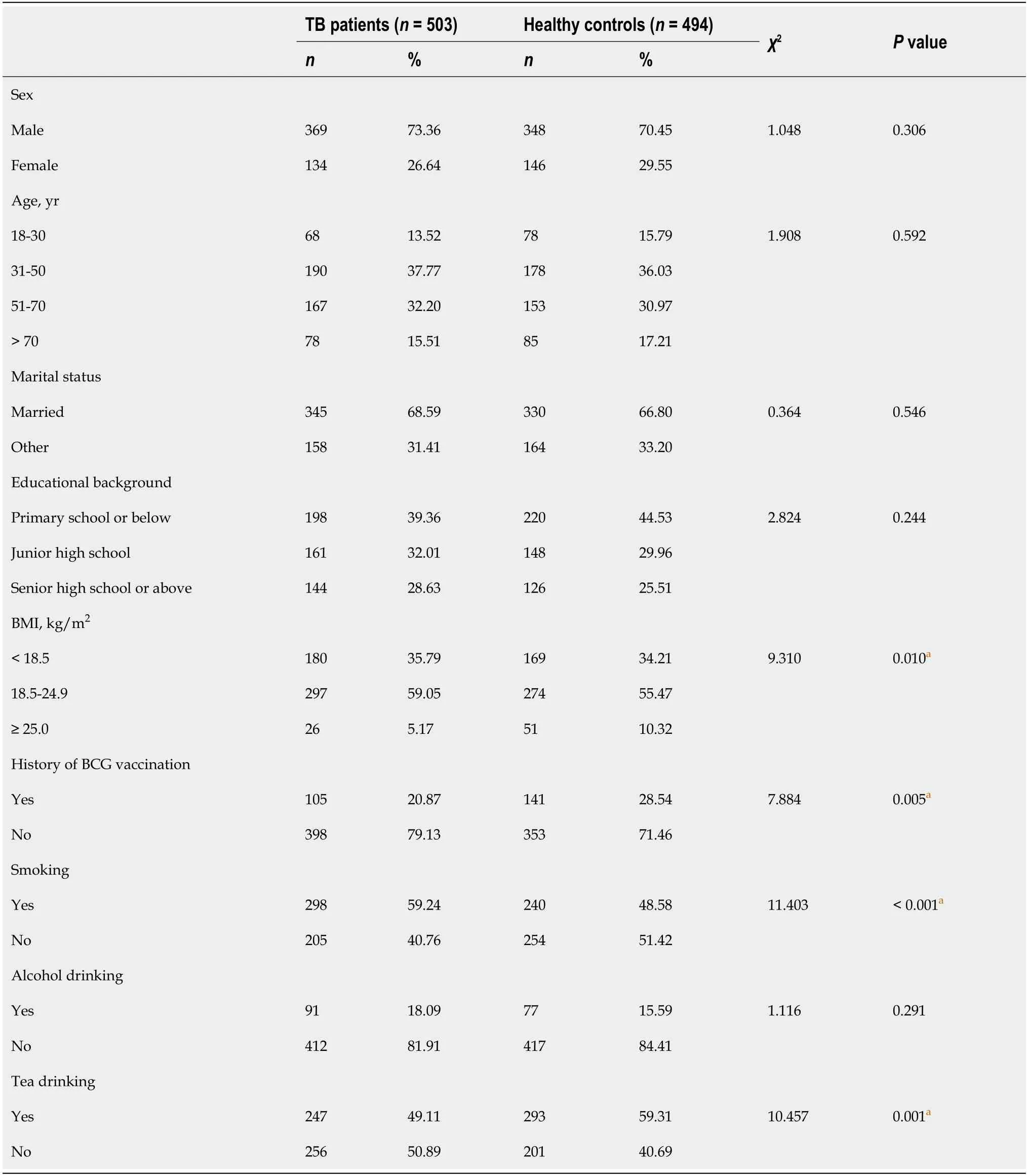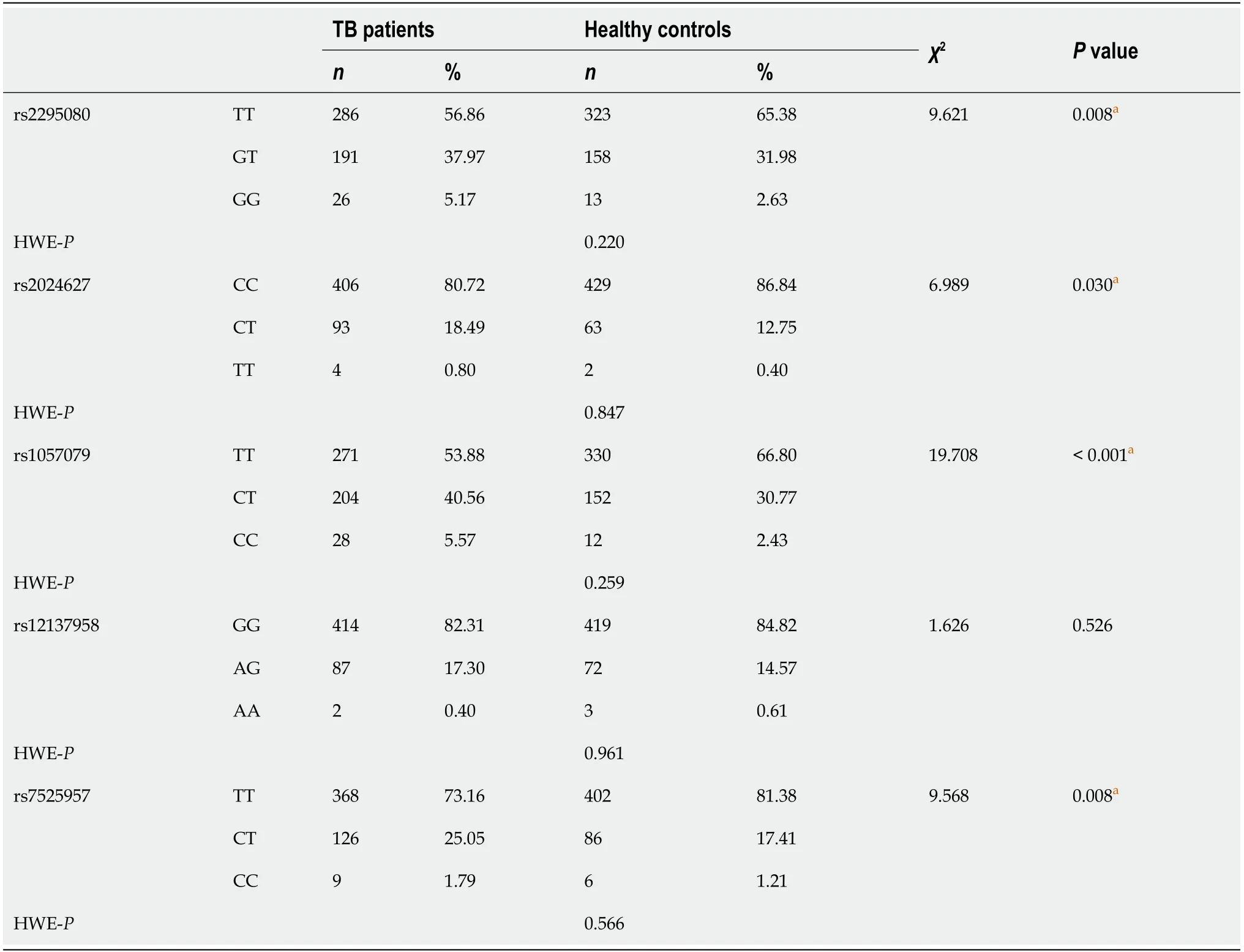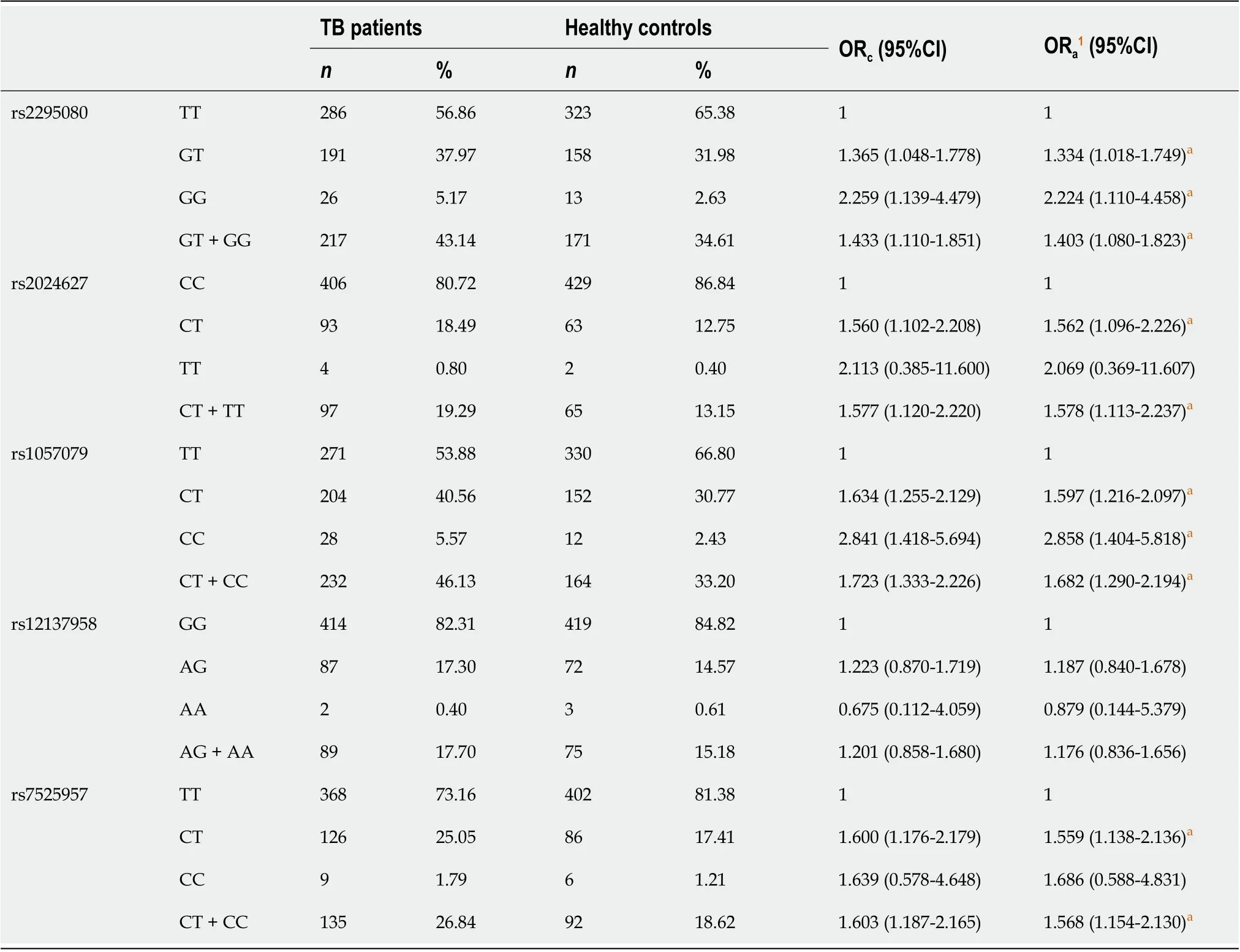Impact of mTOR gene polymorphisms and gene-tea interaction on susceptibility to tuberculosis
2020-04-09MianWangShuJuanMaXinYinWuXianZhangJuliusAbesigZhengHuiXiaoXinHuangHaiPengYanJingWangMengShiChenHongZhuanTan
Mian Wang,Shu-Juan Ma,Xin-Yin Wu,Xian Zhang,Julius Abesig,Zheng-Hui Xiao,Xin Huang,Hai-Peng Yan,Jing Wang,Meng-Shi Chen,Hong-Zhuan Tan
Mian Wang,Meng-Shi Chen,Hong-Zhuan Tan,Hunan Provincial Key Laboratory of Clinical Epidemiology,Xiangya School of Public Health,Central South University,Changsha 410078,Hunan Province,China
Shu-Juan Ma,Xin-Yin Wu,Julius Abesig,Jing Wang,Department of Epidemiology and Health Statistics,Xiangya School of Public Health,Central South University,Changsha 410078,Hunan Province,China
Xian Zhang,Department of Occupational and Environmental Hygiene,Xiangya School of Public Health,Central South University,Changsha 410078,Hunan Province,China
Zheng-Hui Xiao,Hai-Peng Yan,Hunan Provincial Key Laboratory of Pediatric Emergency,Hunan Children’s Hospital,Changsha 410007,Hunan Province,China
Xin Huang,Department of Epidemiology and Health Statistics,Hunan Normal University,Changsha 410008,Hunan Province,China
Abstract BACKGROUND mTOR gene is a key component of the PI3K/Akt/mTOR signaling pathway,and its dysregulation is associated with various diseases.Several studies have demonstrated that tea drinking is a protective factor against tuberculosis(TB).This study was designed to explore five single nucleotide polymorphisms(SNPs)of mTOR in the Han population of China to determine how their interactions with tea drinking affect susceptibility to TB.AIM To investigate if the polymorphisms of mTOR gene and the gene-tea interaction are associated with susceptibility to TB.METHODS In this case-control study,503 patients with TB and 494 healthy controls were enrolled by a stratified sampling method.The cases were newly registered TB patients from the county-level centers for disease control and prevention,and the healthy controls were permanent residents from Xin’ansi Community,Changsha city.Demographic data and environmental exposure information including tea drinking were obtained from the study participants.We genotyped five potentially functional SNP sites(rs2295080,rs2024627,rs1057079,rs12137958,and rs7525957)of mTOR gene and assessed their associations with the risk of TB using logistic regression analysis,and marginal structural linear odds models were used to estimate the gene-environment interactions.RESULTS The frequencies of four SNPs(rs2295080,rs2024627,rs1057079,and rs7525957)were found to be associated with susceptibility to TB(P <0.05).Genotypes GT(OR 1.334),GG(OR 2.224),and GT + GG(OR 1.403)at rs2295080;genotypes CT(OR 1.562)and CT + TT(OR 1.578)at rs2024627,genotypes CT(OR 1.597),CC(OR 2.858),and CT + CC(OR 1.682)at rs1057079;and genotypes CT(OR 1.559)and CT+ CC(OR 1.568)at rs7525957 of mTOR gene were significantly more prevalent in TB patients than in healthy controls.The relative excess risk of interaction between the four SNPs(rs2295080,rs2024627,rs1057079,and rs7525957)of mTOR genes and tea drinking were found to be -1.5187(95%CI:-1.9826,-1.0547,P <0.05),-1.8270(95%CI:-2.3587,-1.2952,P <0.05),-2.3246(95%CI:-2.9417,-1.7076,P <0.05)and -0.4235(95%CI:-0.7756,-0.0714,P <0.05),respectively,which suggest negative interactions.CONCLUSION The polymorphisms of mTOR(rs2295080,rs2024627,rs1057079,and rs7525957)are associated with susceptibility to TB,and there is a negative interaction between each of the four SNPs and tea drinking.
Key Words:Tuberculosis;mTOR;Tea drinking;Gene-environment interaction;The relative excess risk of interaction;Single nucleotide polymorphism
INTRODUCTION
Tuberculosis(TB)is a serious infectious disease caused by Mycobacterium tuberculosis(MTB)and remains one of the most serious challenges to global health.Approximately 10.0 million new TB cases and 1.451 million TB-associated deaths were reported worldwide in 2018[1].The severity of national epidemics varies widely among countries.China is one of the 30 countries with the highest TB cases in the world,with an incidence rate of 61/100000[1].Nearly one-quarter of the world’s population is considered to be latently infected with MTB,whilst only 5%-15% of the infected individuals develop active TB in their lifetime[2].TB was first discovered in different strains of mice and inbred rabbits,which developed different immune responses after infection with MTB[3].Since then,a series of studies including candidate gene screening,twin studies,family linkage analysis,and genome-wide association studies have shown that the incidence of TB varies among different races,ethnic groups,and families,indicating that host genetics influence TB susceptibility[4-6].
As one of the downstream effects of innate immune and adaptive immune pathways,autophagy can directly eliminate intracellular MTB,and it plays an indispensable role in the immune responses against MTB infection[7,8].The formation of autophagy is regulated by a variety of signaling molecules,including the mechanistic target of rapamycin(mTOR),Beclin 1,Ca2+,and p53.Among them,mTOR is at the center of various signaling pathways[9].It is a serine/threonine protein kinase related to the PI3Ks,which senses fluctuations in intracellular and extracellular nutrients to modulate cellular growth,proliferation,metabolism,autophagy,and survival[10,11].mTOR mainly achieves negative regulation of autophagy through Atg13.Phosphorylated Atg13 inhibits the formation of ULK-Atg13-FIP200 complexes,which is necessary for the formation of autophagosome,thereby inhibiting autophagy[12].Moreover,under the action of various growth factors,PI3K/Akt can bind to the tyrosine protein kinase receptor to activate mTOR and inhibit autophagy[13].
Numerous environmental factors are associated with the risk of TB,and the protective effect of tea drinking has been established.Experimental and epidemiologic studies have demonstrated that there is a significantly negative association between tea drinking and TB.Tea polyphenols,especially epigallocatechin-3-gallate(EGCG),protect the immune system from various pathological processes including TB infection due to their antioxidant and free radical scavenging effects[14-16].
Recently,an experimental study confirmed that EGCG could effectively activate PI3K/Akt signaling,leading to the activation of mTOR and inhibition of autophagy[17].Moreover,previous studies have suggested that polymorphisms of themTORgene are associated with susceptibility to various diseases[18-20].Songaneet al[21]observed no significant association betweenmTORgene and TB in a multivariate analysis.However,it is still necessary to explore the relationship betweenmTORgene and TB in other populations.In this case-control study,we investigated five single nucleotide polymorphisms(SNPs,rs2295080,rs2024627,rs1057079,rs12137958,and rs7525957)ofmTORin the Chinese Han population to clarify the role ofmTORpolymorphism and the effect of their interactions with tea drinking on susceptibility to TB.
MATERIALS AND METHODS
Study population
This is a case-control study conducted in 2019.Sample size estimation was based on an estimated C allele ofmTORgene rs7525957 locus frequency of 10%(OR = 1.85,α =0.05,two-sided,unpaired case-control design;and β = 0.15,two-sided).Based on the above assumptions,at least 490 subjects in each group were needed.A stratified sampling method was used to select cases and controls,and the details were reported in our previous publication[22].The cases were newly registered TB patients from five randomly selected county-level centers for disease control and prevention(CDCs,Yueyang County CDC,Qidong County CDC,Hongjiang City CDC,Zixing City CDC,and Yueyanglou District CDC)from the 122 CDCs in Hunan Province.Healthy controls were selected from the permanent residents in Xin’ansi Community(a community in Changsha city)using a gender-age frequency matching method.Included criteria for cases and controls were strictly in accordance with the standards that have been previously described[22].The study protocol was approved by the Medical Ethics Committee of Xiangya School of Public Health,Central South University,No.XYGW-2018-11.The research was carried out in strict accordance with the protocol,and all the included participants(>18 years old)provided written informed consent.
Information and sample collection
Each participant completed a self-administered questionnaire on baseline characteristics and lifestyle,which included information on sex,age,height,weight,education,marital status,smoking status,tea drinking,alcohol consumption,and Bacillus Calmette–Guérin(BCG)vaccination.All the questionnaires were completed by trained research staffs in accordance with the instructions.Blood sample(5 mL)was collected from each participant by certified nurses in EDTA anticoagulant tube and stored at 4 °C immediately.
Selection of SNPs and genotyping
In this study,candidate SNP sites ofmTORwere collected based on the following two points:Firstly,we selected the SNP sites previously associated with susceptibility to TB on PubMed,and secondly,and the SNP sites associated with other infectious diseases.In addition,only loci with a minor allele frequency of at least 5% were included to ensure the statistical efficacy of this study.Using NCBI SNP database(http://www.ncbi.nlm.nih.gov),we searched and learned about the frequencies of corresponding SNP sites ofmTORgene.Finally,five SNPs including rs2295080,rs2024627,rs1057079,rs12137958,and rs7525957 ofmTORgene were selected for analysis in this study.
A Wizard Genomic DNA purification kit(Promega)was used to extract the peripheral white blood cell genome,and the quality-controlled DNA was frozen at -20°C upon collection.The site sequences of rs2295080,rs2024627,rs1057079,rs12137958,and rs7525957 ofmTORgene were identified in the GenBank and Assay Design 3.1(Sequenom)was used to design the appropriate primers.The synthesized primers were subjected to quality assessment by matrix-assisted laser desorption ionization time-of-flight mass spectrometry(MALDI-TOF).The polymerase chain reaction(PCR)volume was 5 µL,which included 1.8 µL distilled water(ddH2O),0.5 µL 10 × PCR buffer,0.4 µL MgCl2(25 mmol/L),0.1 µL dNTP(25 mmol/L),0.2 µL Hotstar,1 µL PCR primer mix,and 1 µL gDNA(20-50 ng).The reaction condition was 95 °C predegeneration for 2 min,amplification(95 °C for 30 s,56 °C for 30 s,and 72 °C for 60 s)for 45 cycles,and 72 °C extension for 5 min.The enzyme digestion reaction system ,included 1.53 µL ddH2O,0.17 µL SAP buffer,and 0.3 µL SAP enzyme;the reaction condition was 37 °C for 40 min and 85 °C for 5 min.Single base extension reaction system was 2 µL,which included 0.619 µL ddH2O,0.2 µL iplex buffer,0.2 µL terminator mix,0.94 µL extension primer mix,and 0.041 µL iplex enzyme;the corresponding reaction condition was 94 °C predegeneration for 30 s,40 cycles of amplification(five cycles of three temperature settings:94 °C for 5 s,52 °C for 5 s,80°C for 5 s,and 72 °C extension for 3 min).Subsequently,resin was purified by plating clean resin on a 6-mg resin plate,and the resin-extended product was transferred to a 384-well SpectroCHIP(Sequenom)chip for spotting(MassARRAY Nanodispenser RS1000).Sequenom MassARRAY®SNP assay was used to determine the difference in bases caused by SNP polymorphism as molecular weight difference.MALDI-TOF was used to detect the molecular weight of the extension product,and the analysis was performed using MassArray TYPER 4.0.SNP typing was determined by the difference in molecular weight.
Statistical analysis
All the statistical analyses were performed using SPSS 23.0 software(SPSS Inc.,Chicago,IL,United States).Continuous variables were presented as mean ± SD and categorical variables were presented as proportions.The independent-samplettest was used for the analysis of continuous variables.The Chi-square test(χ2)was conducted for the comparison of categorical data and Hardy-Weinberg equilibrium detection.Odds ratios(ORs)and the corresponding 95%CIs were calculated to measure the association between each SNP and TB susceptibility using an unconditional logistic regression model,with the adjustment of possible confounders,such as age and sex.The interaction of additive effects between SNP and tea drinking was analyzed and the relative excess risk of interaction(RERI)was used to estimate if the main effect on TB was meaningful.Point estimation and interval estimation of RERI were calculated using Marginal Structural Linear Odds Models[23].RERI >0 indicates positive interactions.All statistical tests were two-sided and aPvalue <0.05 indicated statistical significance.
Biostatistics statement
The statistical methods of this study were reviewed by Meng-Shi Chen from the Department of Epidemiology and Health Statistics,Xiangya School of Public Health,Central South University.
RESULTS
A total of 503 TB patients and 494 healthy controls were included in the study.There was no statistically significant difference(P>0.05)in terms of sex,age,marital status,educational background,and alcohol consumption between the two groups.Differences in body mass index(BMI),history of BCG vaccination,smoking status,and tea drinking were statistically significant(P<0.05)(Table 1).
The distribution of SNPs at the selected five sites of themTORgene in each group is shown in Table 2.The genotypic distributions in TB patients and healthy controls were tested separately for Hardy-Weinberg equilibrium.No significant deviation was observed with all the five polymorphism sites(P>0.05).
The univariate analysis showed that the genotypes of rs2295080(χ2= 9.621,P<0.05),genotypes of rs2024627(χ2= 6.989,P<0.05),genotypes of rs1057079(χ2= 19.708,P<0.001),and genotypes of rs7525957(χ2= 9.568,P<0.05)were closely associated with TB incidence.In addition,no statistically significant difference was observed in the genotypes of rs12137958 between the two groups(P>0.05).Genotype TT at rs2295080,genotype CC at rs2024627,genotype TT at rs1057079,and genotype TT at rs7525957 were all less prevalent in TB patients.Moreover,genotype TT at rs2024627 and genotype AA at rs12137958 were rare in the participants(Table 2).
Further multivariate unconditional logistic regression analysis confirmed that rs2295080,rs2024627,rs1057079,and rs7525957 ofmTORgene were associated with susceptibility to TB.Genotypes GT,GG,and GT + GG at rs2295080;genotypes CT and CT + TT at rs2024627;genotypes CT,CC,and CT + CC at rs1057079;and genotypes CT and CT + CC at rs7525957 ofmTORgene were significantly more prevalent in TB patients than in healthy controls(Table 3).
Marginal structural linear odds models were used to examine the interactions between the selected five sites of themTORgene and tea drinking.After adjusting for the covariates of sex,age,marital status,educational background,BMI,alcohol drinking,smoking status,and history of BCG vaccination,the RERI between rs2295080 ofmTORgenes and tea drinking was -1.5187,which suggests negative interactions(Table 4).Similarly,negative interactions were also observed between each of the other three sites(rs2024627,rs1057079 and rs7525957)of themTORgene and tea drinking,with the adjusted RERI of -1.8270,-2.3246,and -0.4235,respectively(Table 4).
DISCUSSION
This case-control study examined the association betweenmTORpolymorphisms and TB susceptibility as well as their interactions with tea drinking.It is noteworthy that the frequencies of four SNPs(rs2295080,rs2024627,rs1057079,and rs7525957)ofmTORgene were associated with susceptibility to TB.However,no association was observed between the genotypes of rs12137958 and TB incidence.
mTORgene is a key component of the PI3K/Akt/mTOR signaling pathway,and its dysregulation is associated with the pathogenesis and progression of various cancers[20,24].Although the reason for this anomaly is still controversial,it is biologically plausible that functional SNPs of themTORgene may contribute to cancer susceptibility[25].In vitrostudies have revealed a higher transcription activity ofmTORin the presence of rs2295080 T allele in 786-O,HEK293,GES-1,and HeLa cell lines.Similarly,individuals with TT genotypes have highermTORmRNA level[18,26].These indicate that the rs2295080 T allele could probably increase the affinity of special transcription factors to themTORpromoter region and subsequently contribute to the enhanced mTOR activity in humans[26].Multiple population studies have confirmed thatmTORpolymorphisms affect the susceptibility of various kinds of cancers.In previous studies,individuals with TG/GG genotype displayed a significantly decreased susceptibility to gastric cancer,colorectal cancer,and breast cancer,compared with those carrying rs2295080 TT genotype[26-28].For SNP rs1057079,the G allele carriers are at higher risk of developing esophageal squamous cell carcinoma,colon cancer,and breast cancer[29-31].In addition,rs2024627,located in the intron,affects the expression ofmTORgene[32],and it is recommended as a genetic marker of pharmacogenetics of kidney transplant[33].Our results showed that the frequencies of our SNPs(including rs2295080,rs1057079,and rs2024627)ofmTORgene were associated with TB susceptibility,suggesting that these functional SNPs ofmTORgene might play a critical role in the prediction of susceptibility to TB.
To our knowledge,no report has been made on the association of rs12137958 or rs7525957 ofmTORgene with TB susceptibility.Although we speculate that these SNPs with unknown functional effects on exons or introns may affect the binding capacity of transcription factors and subsequent gene transcription,an explanation for the correlation should be determined in future mechanistic biological studies.Several studies have demonstrated that mTOR targeted therapies could be designed to block the induction of the prosurvival,proliferative,and oncogenic functions of mTOR[34].Therefore,this finding is important not only for the understanding of the pathogenesisof TB,but also for the identification of high-risk populations of TB and the development of appropriate population-specific prevention measures to control the spread of TB.

Table 1 Demographic characteristics and associated risk factors in tuberculosis patients vs.healthy controls
Moreover,marginal structural linear odds model analysis showed that there were negative interactions between rs2295080,rs2024627,rs1057079,and rs7525957 ofmTORgenes and tea drinking,which suggests that when mutations occur in these four SNPs ofmTORgenes,the risk for TB will decrease for individuals that drink tea regularly.Additionally,our previous study confirmed that increasing tea consumption is associated with a decreased risk of TB[15].Moreover,some studies have demonstrated that catechin,an important antioxidant extracted from tea leaves,can protect cellsfrom damage by inducing antioxidant enzymes,inhibiting oxidase,and scavenging free radicals[14,16].EGCG,which is the most potent component in catechins,plays an important role in arresting the growth of tubercle bacillus.Previous studies demonstrated that EGCG could inhibit the transcription oftryptophan-aspartate containing coat protein(TACO)gene,which is essential in the entry and intracellular survival of mycobacteria[35].Anandet al[16]found that EGCG could inhibit Sp1 transcription factor,a DNA-binding protein located in the promoter region ofTACOgene,and block the binding of Sp1 binding sequence to the promoter region of fatty acid synthase gene,thus down-regulating the expression ofTACOgene.Genetic mutations cannot be altered,and hence,our findings suggest that promoting tea drinking may be considered a new way to reduce the risk of developing TB for individuals with mutations in these four SNPs.

Table 2 Genotypes of the mTOR gene in the two groups
This study had some limitations.Firstly,TB is a complex disease,and the genetic background of the study population or the difference in environmental exposure led to an inevitable heterogeneity between studies and a limited control of confounding factors in the study.Hence,the analyses of gene-gene,gene-environment,and environment-environment interactions are required.Secondly,only five potentially functional SNPs ofmTORgene were investigated in the present study,which did not cover all the variants inmTORgene,and the importance of combining SNPs was neglected.Hence,the results could not fully represent the role of mTOR genetic susceptibility factors in TB.A joint analysis of multiple genes or multiple sites of the same gene will facilitate the discovery of true positive associations and the elucidation of the mechanism of these genetic variants.

Table 3 mTOR gene polymorphism vs.tuberculosis incidence
CONCLUSION
The present study provides evidence of the association betweenmTORpolymorphism and TB susceptibility.Rs2295080,rs2024627,rs1057079,and rs7525957 ofmTORgene were associated with significant increased risk of TB in a Chinese population.In addition,there was a negative interaction between each of the four SNPs and tea drinking.Nevertheless,these findings should be verified by larger independent population-based studies.

Table 4 Impact of interactions between genotypes of mTOR gene and tea drinking on incidence of tuberculosis
ARTICLE HIGHLIGHTS
Research background
Tuberculosis(TB)is a serious infectious disease caused by Mycobacterium tuberculosis.The incidence of TB has been shown to vary among different races,ethnic groups,and families,indicating that host genetics influence TB susceptibility.mTORgene is a key component of the PI3K/Akt/mTOR signaling pathway,and its dysregulation is associated with various diseases.In addition,several studies have demonstrated that tea is a protective factor against TB due to its antioxidant and free radical scavenging effects.
Research motivation
Investigations have suggested that polymorphisms of themTORgene are associated with susceptibility to various diseases.And epigallocatechin-3-gallate,the major component of tea catechins,could effectively activate PI3K/Akt signaling,leading to the activation of mTOR and inhibition of autophagy.The role ofmTORpolymorphisms in TB is still inconclusive.Moreover,whether there is any interaction on TB risk between tea drinking and polymorphisms ofmTORgene has not been reported.
Research objectives
This study aimed to investigate five single nucleotide polymorphisms(SNPs)ofmTORin the Han population of China to determine how their interactions with tea drinking affect susceptibility to TB.
Research methods
In this case-control study,503 TB patients and 494 healthy controls were enrolled by a stratified sampling method.The cases were newly registered TB patients from the county-level centers for disease control and prevention,and the healthy controls were permanent residents from Xin’ansi Community,Changsha city.Demographic data and environmental exposure information including tea drinking were obtained from the study participants.We genotyped five potentially functional SNP sites(rs2295080,rs2024627,rs1057079,rs12137958,and rs7525957)ofmTORgene and assessed their associations with the risk of TB using logistic regression analysis,and marginal structural linear odds models were used to estimate the gene-environment interactions.
Research results
The frequencies of four SNPs(rs2295080,rs2024627,rs1057079,and rs7525957)were found to be associated with susceptibility to TB(P<0.05).Genotypes GT(OR 1.334),GG(OR 2.224),and GT + GG(OR 1.403)at rs2295080;genotypes CT(OR 1.562)and CT+ TT(OR 1.578)at rs2024627,genotypes CT(OR 1.597),CC(OR 2.858),and CT + CC(OR 1.682)at rs1057079;and genotypes CT(OR 1.559)and CT + CC(OR 1.568)at rs7525957 ofmTORgene were significantly more prevalent in TB patients than in healthy controls.The relative excess risk of interaction between the four SNPs ofmTORgenes and tea drinking was found to be -1.5187(95%CI -1.9826,-1.0547,P<0.05),-1.8270(95%CI -2.3587,-1.2952,P<0.05),-2.3246(95%CI -2.9417,-1.7076,P<0.05)and -0.4235(95%CI -0.7756,-0.0714,P<0.05),respectively,which suggest negative interactions.
Research conclusions
The polymorphisms ofmTOR(rs2295080,rs2024627,rs1057079,and rs7525957)are associated with susceptibility to TB,and there is a negative interaction between each of the four SNPs and tea drinking.These findings are significant for identifying populations with high risk of developing TB,and suggest that preventive measures through promoting the consumption of tea should be emphasized in the high-risk populations.
Research perspectives
Since TB is a complex disease involving various factors including heredity,biology and environment,the genetic background of the study population or the difference in environmental exposure may lead to an inevitable heterogeneity between studies.Hence,larger independent population-based studies in different countries or ethnic groups are required to validate our initial findings.
ACKNOWLEDGEMENTS
We thank Dr.Li-Qiong Bai and Dr.Zu-Hui Xu(Hunan Institute of Tuberculosis Prevention and Treatment)for their input into this work.
杂志排行
World Journal of Clinical Cases的其它文章
- Role of monoclonal antibody drugs in the treatment of COVID-19
- Review of simulation model for education of point-of-care ultrasound using easy-to-make tools
- Liver injury in COVID-19:A minireview
- Transanal minimally invasive surgery vs endoscopic mucosal resection for rectal benign tumors and rectal carcinoids:A retrospective analysis
- Establishment and validation of a nomogram to predict the risk of ovarian metastasis in gastric cancer:Based on a large cohort
- Predictive factors for early clinical response in community-onset Escherichia coli urinary tract infection and effects of initial antibiotic treatment on early clinical response
